Last week as I drove along the causeway to Antelope Island just after sunup I came across a Pied-billed Grebe on the shore that was being tormented by a Common Raven. I still don’t fully comprehend what I witnessed. I’ll try to explain it using the photos I got but they’re of poor quality because of sidelight, too much lens and too little depth of field (for two active subjects) and the inevitable consequences of trying to drive and photograph at the same time.
I had passed by these birds when Mia noticed them so I had to back up to see what was going on. The grebe was covered with sand and the raven kept walking around it with great interest.
Occasionally the grebe would try to run away…
but with the leg placement so far back on the body (typical of grebes) the bird was extremely awkward…
and it did several face plants into the sand as it was trying to run at full speed (naturally I lost focus for this shot but you still get the idea).
Each time the raven followed the grebe. I fully expected the grebe to be killed…
but it never happened. The grebe got up and attempted to run one last time and eventually the raven flew off…
leaving the grebe to sit on the sand and contemplate its next move. We watched it for several more minutes and when nothing more happened we drove on to the island.
I’m puzzled by several things in this little mini-drama:
- Why didn’t the raven kill and eat the grebe? It was definitely interested and even though ravens are largely scavengers they’re well-known for taking prey significantly larger than this diminutive and relatively defenseless grebe.
- What was the grebe doing on land in the first place? It’s rare for them to ever leave the water (except for flight during night migration). I’ve spent hundreds of hours observing the species and I’ve only seen them out of the water 3 times and that was usually a momentary event to avoid another grebe trying to steal its fish.
- Why didn’t the grebe try to escape to the water at the first opportunity? You can see in the first three photos how close it was to the shore of the lake. It would have had no problem making it to the relative safety of the water, given the luke-warm pursuit of the raven.
- Was the grebe healthy? I get conflicting cues on that. It seemed alert, it could run (as well as grebes can run) and I didn’t notice any obvious injury. But it was on land, covered in sand and it was acting strangely as noted above.
I’ll probably never know the answers.
But I’m fascinated by watching these kinds of events and trying to figure them out. Part (only part) of the fun of bird photography.
Ron
Note: I should explain that Pied-billed Grebes can’t take off from land – they must get a running start on the surface of water. Their normal defense when pursued by predators is to crash-dive.
Another note: I’ll be out of town for a few days and expect to have spotty internet access at best so I’ll likely be unable to respond to many comments until my return.


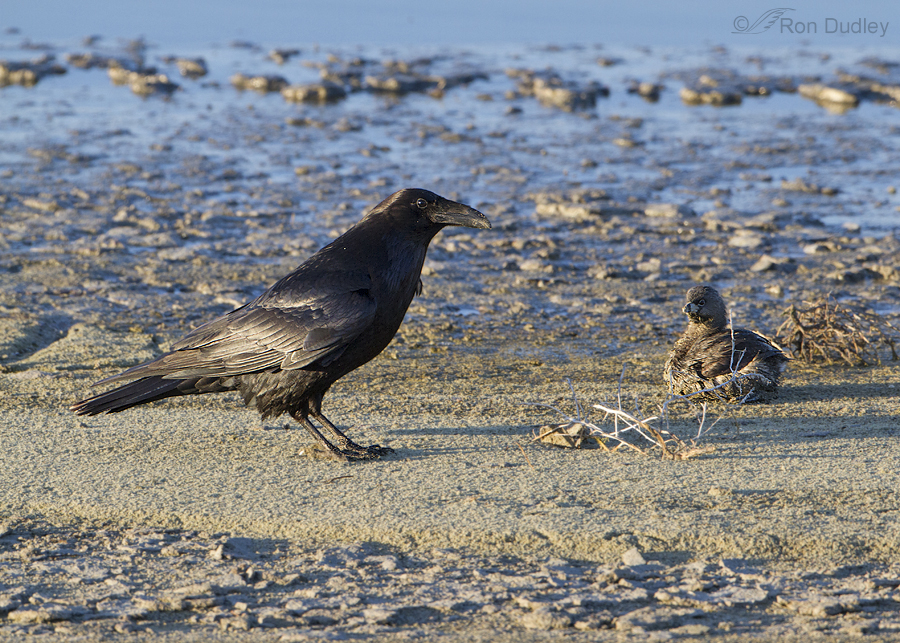

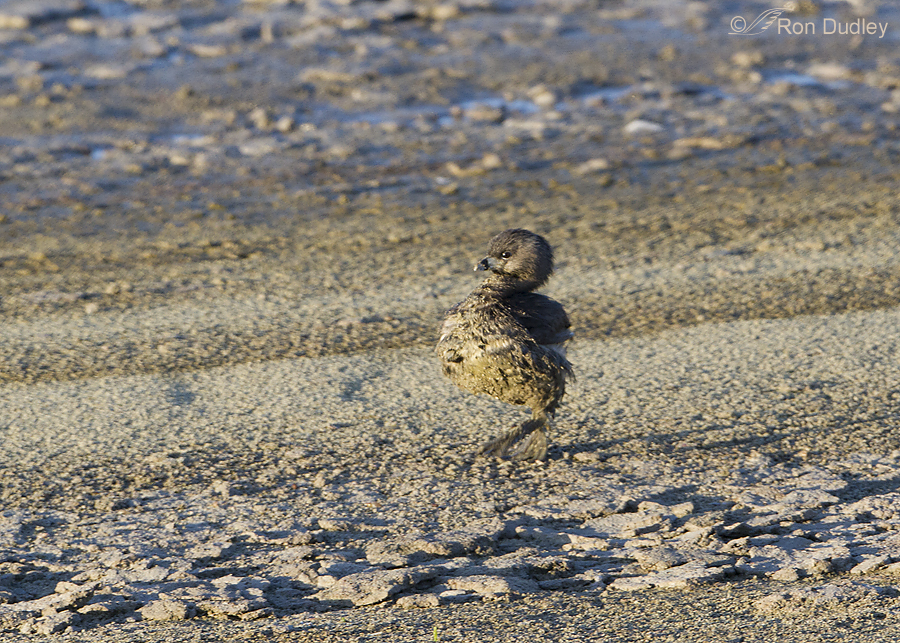
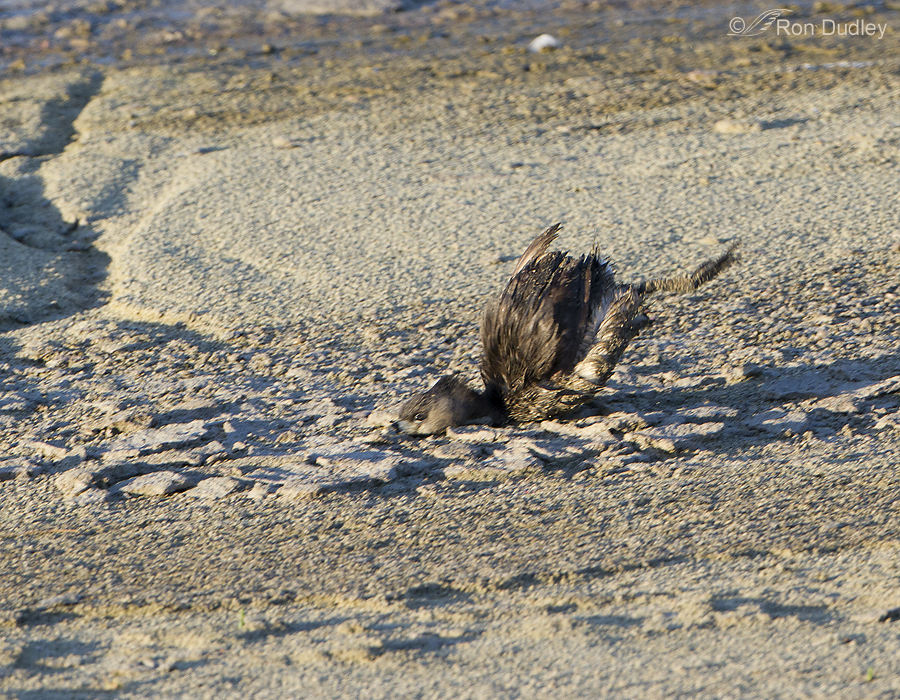
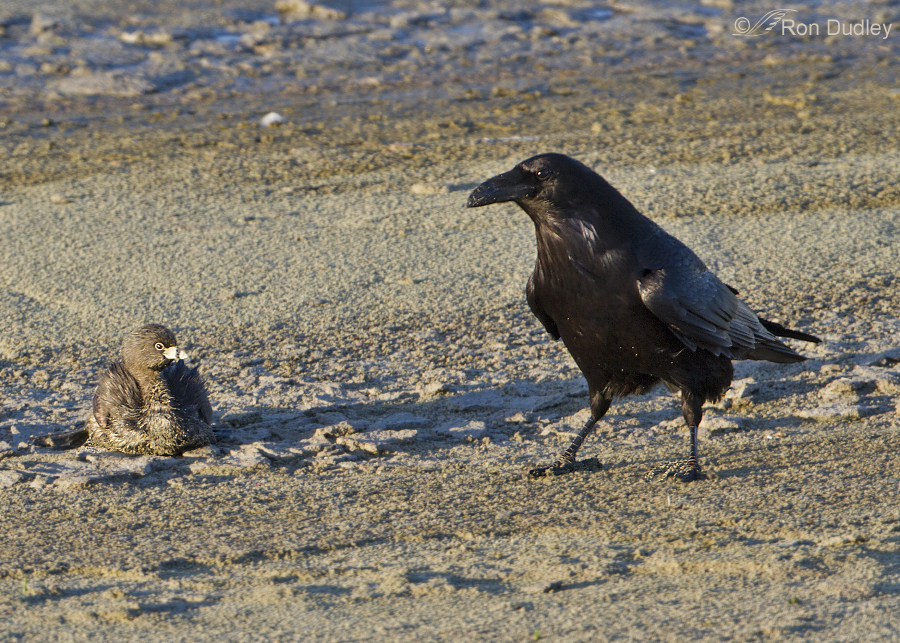
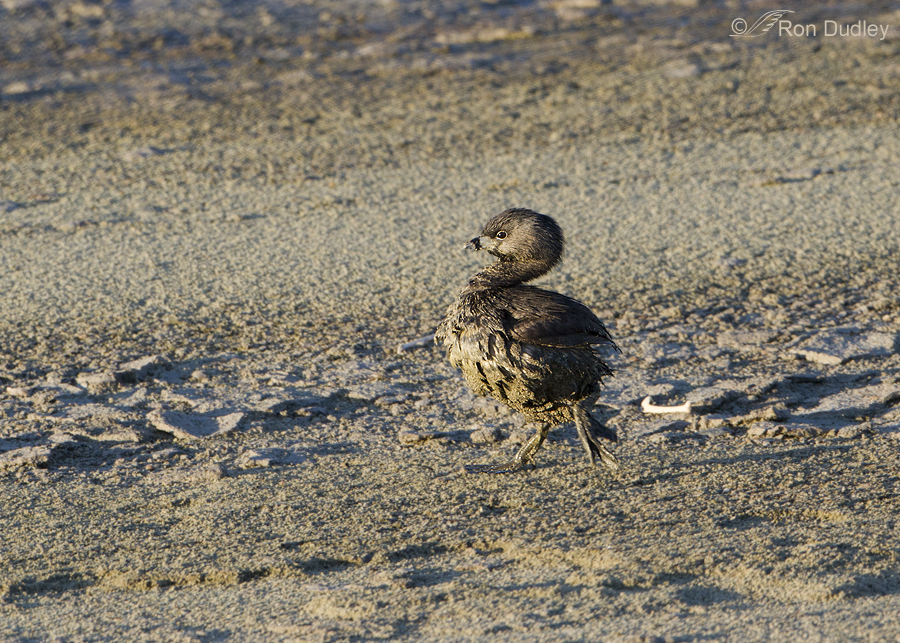

Ron, my guess was that the grebe wasn’t entirely well, based on the land-based behavior. Is there any chance the bird was lightly oiled and trying to get warm? Oiled birds who seem otherwise un-injured will head to land because hypothermia will overtake if they remain in the water without the waterproof protection that oiling destroys. As far as the Raven’s behavior, my usual, pat response is that nature isn’t as much tooth-in-claw as we think, owing to the complexity of bird behavior, understanding and emotional complexity — especially birds of such high intelligence as Ravens. I think curiosity, as others have posited, is as good a guess as any. Or, perhaps, there was something wrong with the grebe that dissuaded the Raven from pursuing.
Not sure where my mind is! I meant to say isn’t as much “red in tooth and claw.”
The strangest thing is that the Pie-billed Grebe is out of the water. To me, that implies an injury or illness.
The simplest explanation for the Raven is that it wasn’t hungry. At the risk of oversimplifying, carnivores kill whether they are hungry or not in the presence of helpless prey. It’s more or less a reflex. Omnivores likes Ravens don’t have that quasi-reflex. And, as you say, Ravens are intensely curious. I’ve watched them obsessively stare at things.
The next simplest explanation is that the Raven was a female and, because small Grebes look a bit like young Ravens, a maternal reflex got triggered.
Excellent photos as always, Ron. Fine work.
/WC
Curiosity has my vote. As I understand it, ravens are intelligent birds who are noted for their curiosity. If the raven had recently fed well, then curiosity was perhaps the stronger drive?
So cute! I saw a small rabbit and a magpie yesterday outside the building in the garden. The magpie would pinch the bunny in the butt,teasing it, not attacking and the bunny, which looked like either a domestic or a baby was up on its hind legs punching at the magpie.It was cute but potentially serious and I ran in for the camera and when I got back the bunny was gone and the magpie appeared to be looking for it. I found out that though magpies won’t kill it they will poke it’s eyes out, so was on the bunny’s side.Keeping a lookout for it.By the antics of the magpie searching under shrubs, I believe the bunny made a safe getaway. So do not know why this raven did not kill the grebe-maybe it had already eaten.Totally fascinating and comical.
What an amazing set of photos! I’ve never seen any kind of grebe on land before. I just hope that this one is okay – it looks to be very alert. Another bird worth visiting Antelope Island for…
Ron – Great photos as usual and a very interesting situation to observe. I would assume that the Raven was just curious – since they are a smart and inquisitive sort. I never underestimate the behavior of birds and I am learning all the time. It is good to keep your eyes and senses open to all of nature since there are insights to be had. Now – about that thing of driving and photographing…
Dear Ron, your photographs could inspire a children’s story or even be the catalyst for an adult story with characters in a situation like that of the grebe and the raven. But, as you say and as “Dick Harlow” has commented, we really don’t know the ramifications or significance of that situation.And so, for me, the photographs are endlessly fascinating as they relate a mystery. Peace.
I think we over analyze situations like this. We as humans are not the only animals to show curiosity in another organism without causing harm. The Raven was obviously interested in the grebe, and could have taken it down easily, but didn’t because, as you have so ably shown, was only curious in the grebe. We can anthropomorphize all we want, but I tend to think the Raven was testing the grebe. If the grebe was injured, you would have seen a kill. Since the grebe ran, albeit awkwardly, the Raven was ultimately convinced not to spend the energy killing it. Or, was the Raven just enjoying (human speak) testing the little guy, and eventually was tired of the game. Also, could your vehicle have entered the equation? You will never know.
Very interesting set of images Ron, many thanks for sharing the behavior and asking the questions.
Just my spin!
Thanks, Dick. You’re probably right about my tendency to over-analyze, particularly in this case given the well known curiosity of ravens. I enjoyed your “spin”, as always.